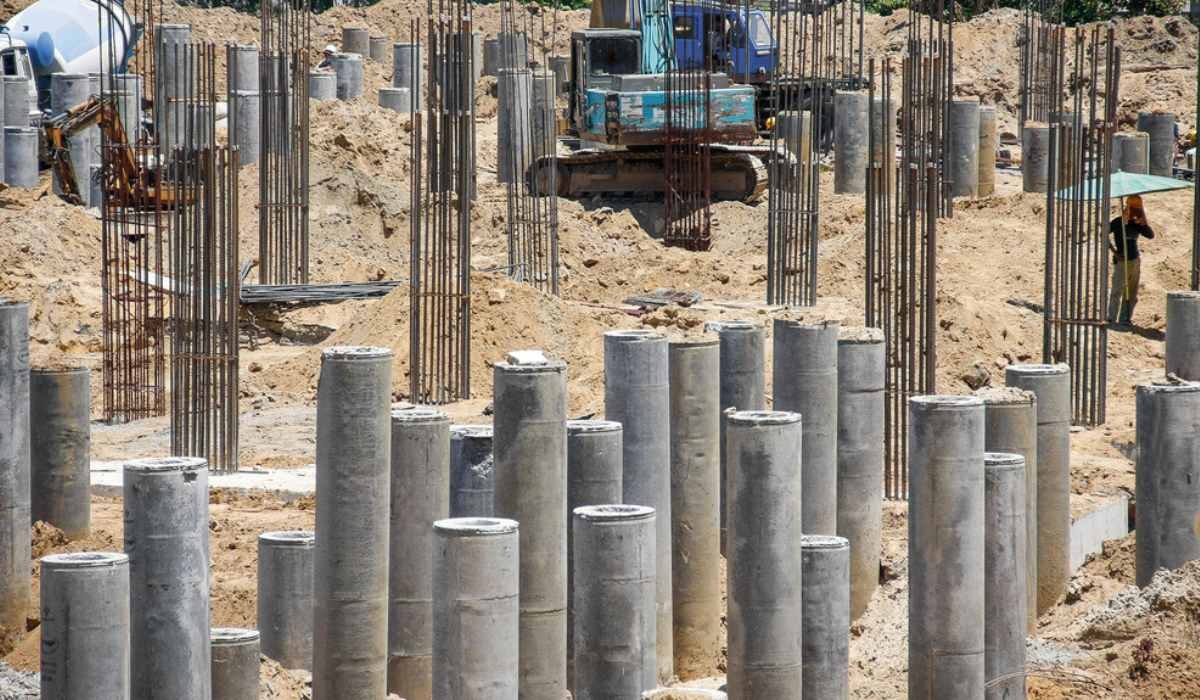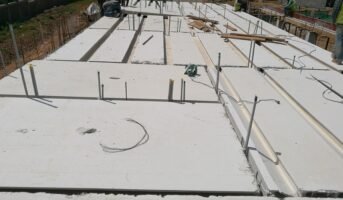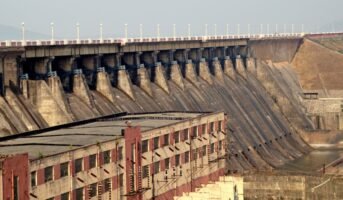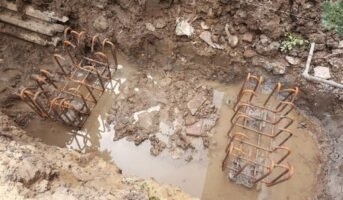Pile foundations are a kind of deep foundation that consists of a thin column or long cylinder constructed of materials like concrete or steel to support the building and transmit the load at the necessary depth by either end bearing or skin friction. To ensure the stability of the buildings constructed above them, piles are driven deep into the earth. Through the use of piles, heavy loads may be distributed to more stable subsurface materials like rock or hard soil. The piles are firmly embedded in the ground, providing structural support. Pile foundations, because of their embedded nature, are more resistant to scour and erosion.
See also: Deep foundation: Importance and types
Pile foundation: Need
Pile foundations are utilised to transfer loads from the superstructure to bedrock or a stronger soil layer when one or more of the topsoil layers is very compressible and cannot maintain the load. They are able to withstand horizontal stresses by bending, while still bearing the vertical load from the above structure. Typically, this kind of issue arises during the planning and building stages of earth-retaining structures and the foundations of tall buildings in areas prone to strong wind speeds and/or earthquakes.
The soil at a potential building site may be too expansive or prone to collapse. Possible deep subsurface penetration of these soils has been documented. A pile foundation may be utilised in this situation if the piles are driven deep enough into the ground to reach stable soil layers outside of the moisture-changing zone. They are often used for bridge abutments and piers to prevent the loss of bearing capacity that may occur with a shallow foundation due to soil erosion.
see also about: pile concrete
Pile foundation: Applications
- Shifts the burden to a layer that is either more solid or has less compression.
- The pile’s contact with the earth allows it to transfer weights even on unstable ground.
- It is used in case the foundation has granular dirt that is compact yet still loose.
- Create a firm base and slanted forces with the help of the bridge abutment and the retaining walls.
- The amplitude and the natural frequency of the system’s vibrations may be controlled by strengthening the soil underneath the machine’s base.
know about: Piling foundation
Pile foundation: Piling construction types
1. End-bearing piles
Most friction for end-bearing piles is generated near the pile’s toe, which is bearing on the hard layer. The pile transfers weight to solid ground and is constrained laterally by the ground below.
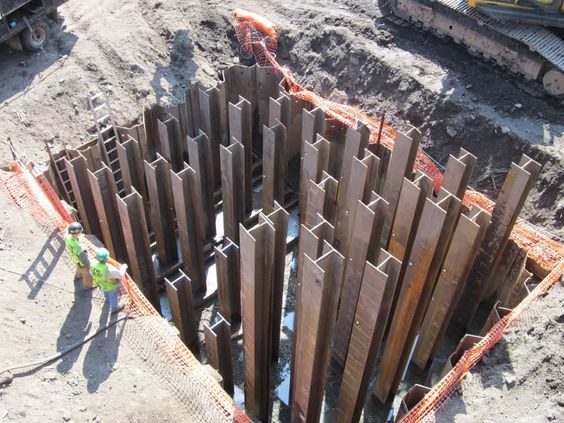
Source: Pinterest
2. Friction piles
Shear pressures around the sidewalls of the pile are responsible for the majority of the pile’s bearing capacity, making friction (or floating) heaps an excellent choice when harder layers are too deep. Friction between the pile’s surface and the soil reduces the bulb of pressure, allowing the pile to transfer its weight to the surrounding soil.
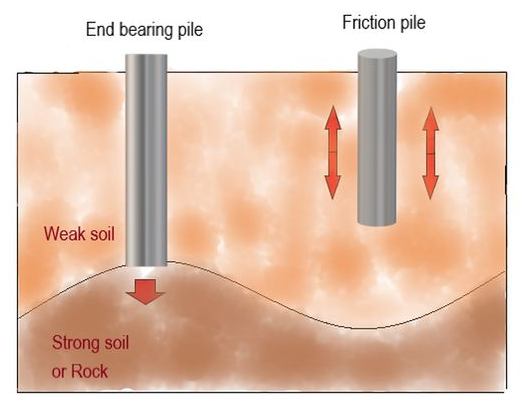
Source: Pinterest
3. Driven piles
Instead of removing the soil from surrounding the pile shaft, driven (or displacement) piles are driven, jacked, vibrated, or screwed into the earth. Driven piles are stable in soft compressing soils and may densify loose soil, making them valuable in offshore applications. Driven piles may be divided into two categories:
- The casing may be concrete or steel and may be permanent or temporary, and the drive may take place directly in the ground.
- Construction materials such as wood, concrete, and steel are performed at a factory before being sent to the job site.
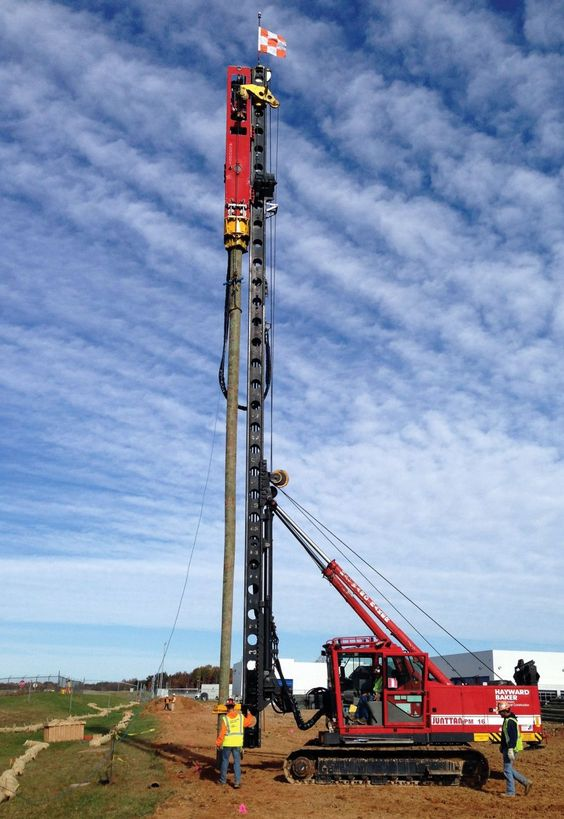
Source: Pinterest
4. Bored piles
Bored piles, also known as replacement piles, involve the removal of debris to create a hole into which the pile will be poured on the spot. Most often, they are employed to create friction piles in cohesive subsoils and to construct pile foundations near already existing structures. In urban locations, bored piles are preferred because of their reduced noise and vibration, their ability to be installed in tight spaces, their lack of heave danger, and the potential need to adjust their length.
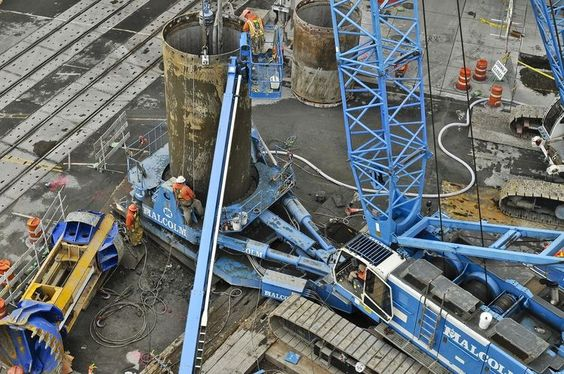
Source: Pinterest
Pile foundation: A breakdown of construction material
Timber piles:
Out of all the modern piles in use, timber piles are the most conventional and have been around the longest. A pile drive or, less often, vibratory installation is used to set these precast displacement piles.
Steel piles:
Steel piles are driven to the required depth and resistance using impact or vibration hammers. To back up your construction, you may have anything from tiny tube piles to massive steel caissons pushed into the ground.
Concrete piles:
Offshore buildings, including bridges, oil rigs, and floating airports, often include concrete piles as their structural base. There is still a lot of room for exploration in the realm of offshore structures since they are still relatively novel methods. An offshore structure’s loading is made up of two parts: vertical structural loads and lateral wave loads.
Pile foundation: Installation
Pile drivers use a hammer or a hydraulic ram to force the precast piles into the earth. For driving piles into the earth at an angle, a special machine called a pile driver is used. Repeated blows are delivered by raising a heavy object above the stack and letting it fall on top of the pile. To determine how deep a pile should be pushed into the earth, the refusal point must be determined.
FAQs
What is a pile foundation, and what kinds are there?
A pile foundation is a set of columns that are built or put into the ground to move weight to a lower level of subsoil. End-bearing piles and friction piles are the two main types of piles. End-bearing piles send loads straight to a strong layer of soil or rock that is a good distance below the surface. Friction piles move loads by causing friction between the soil and the pile's surface along its entire length.
When is it necessary to install a piling foundation?
In regions where the soil is unstable and the buildings being built are massive and heavy, pile foundations are required. In places prone to settling owing to soil liquefaction or water table problems, pile foundations are the best option.
| Got any questions or point of view on our article? We would love to hear from you.
Write to our Editor-in-Chief Jhumur Ghosh at [email protected] |
Housing News Desk is the news desk of leading online real estate portal, Housing.com. Housing News Desk focuses on a variety of topics such as real estate laws, taxes, current news, property trends, home loans, rentals, décor, green homes, home improvement, etc. The main objective of the news desk, is to cover the real estate sector from the perspective of providing information that is useful to the end-user.
Facebook: https://www.facebook.com/housing.com/
Twitter: https://twitter.com/Housing
Email: [email protected]
